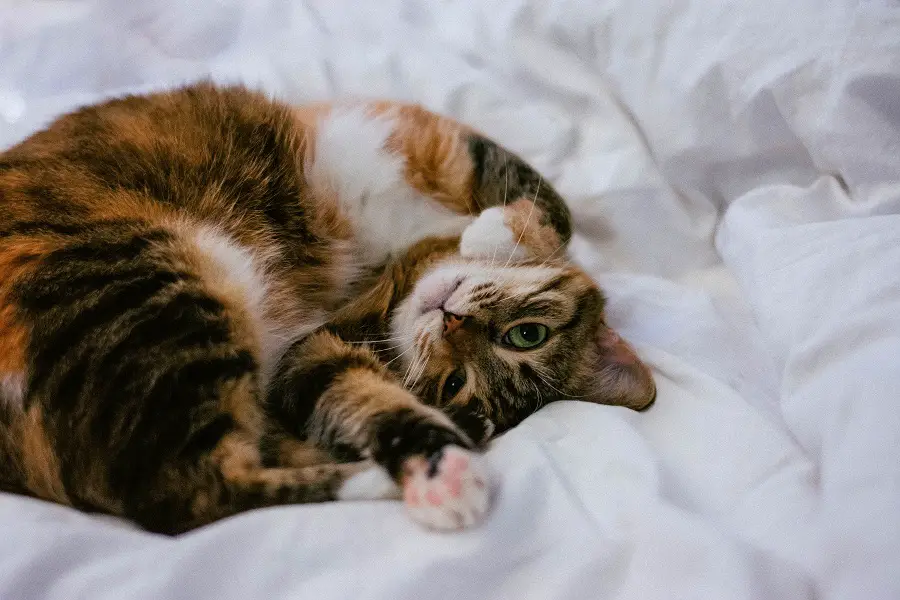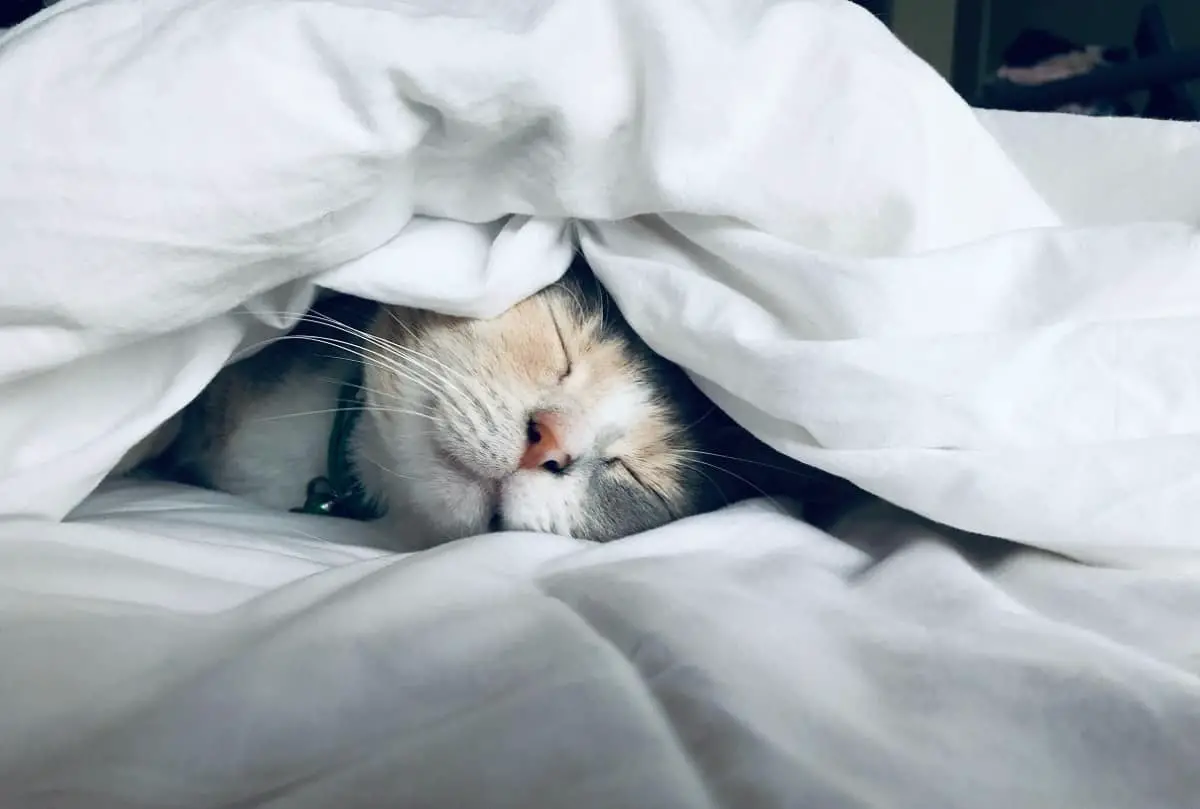Table of Contents
**This page contains affiliate links and I will be compensated if you make a purchase after clicking on my links**
Photo by Kate Stone Matheson on Unsplash
Comforters and duvets are very similar and sometimes the term is used interchangeably.
So, yes, you may use a duvet cover on a comforter
In general, duvets tend to be thicker and fluffier and designed to have a cover. They may even include little loops along the outside edge to attach to a cover.
This cover is sometimes purchased with the duvet, or sometimes separately.
The cover is open on one end and will close with either a series of buttons or even a zipper.
For moderate temperatures, use a thin cover, made of a cooling fabric. For colder weather, you have the option of switching to a thicker “minky” fabric cover.
Comforters are usually a bit thinner and intended to be used as is, without a cover. But there’s no reason you can’t add one.
You have the option of sewing on your own ties along the edge of the comforter, but that’s optional.
Without ties, your comforter may shift around within the cover, but it’s easy to realign everything by grabbing two corners and shaking the entire thing out.
Why would you wish to use a duvet cover with a comforter?
Improve your décor with a fancy duvet cover
In the old days, you used a bedspread to improve the look of your made-up bed.
(Some outdated budget hotels still use them. Ick.)
But for a while now we’ve simply been using our duvet or comforter as the top layer of our bed.
However, most duvets or comforters come in boring solid colors. Like white.
If you’re a minimalist, you’re done.
For the rest of us, we might want a fancy pattern or color that matches the rest of our bedroom décor.
Of course, there are also those of us that like to change our décor often. Navy was big last year. Now you want a pale peach print. Or aubergine?
Switching the cover is a cost-effective way of changing the look of your room.
Protect your duvet or comforter with a cover
If your comforter is made of a silky fabric such as lyocell, or real silk, then it may be at risk from thread pulls from tiny cat claws.
However, the biggest reason to use a cover is to protect your duvet or comforter from you. Namely, your dirt, oils, and other bodily fluids…
Ideally, you should be throwing all your bedding into the washing machine with hot water.
This is especially important if you have allergies. Only hot water (≥ 130 F) will destroy both dust mites and allergens.
Your comforter might fit in your washing machine, but your larger duvet may not…
Alternatively, your comforter could be stuffed with wool or other material that shouldn’t be machine-washed.
In that case, you’ll definitely need a cover.

Photo by Anton Lochov on Unsplash
Need even more protection? Use a waterproof cover
Perhaps you have a beloved pet with bladder issues? Or you like to drink red wine in bed?
You can purchase a waterproof duvet cover or simply a waterproof blanket to lay on top of your bedding.
Don’t worry, modern waterproofing is made from a layer of polyurethane, a breathable material.
This is very different from the vinyl of old, which famously didn’t breathe, and left you sweating.
As a bonus, these types of protective covers usually also block dust mites and other allergens. This is important if you are unable to wash the duvet inside.
These duvet protectors usually come only in boring white. However, there’s no reason you can’t use two duvet covers, with a more decorative cover on the outside.
Wash your cover regularly
If you’ve been to Europe lately, one thing you may find is that they skip the top sheet and simply provide you with a covered duvet. This cover is made of the same material as your typical sheet, such as cotton.
As this cover rests directly on you, it’s important that your dirt and oils are laundered off.
In this case, this cover should be machine-washed as often as you launder your sheets, or once weekly.
Stuffing the duvet or comforter back into its cover is a bit of a pain (see below) so it seems eminently more practical to use a top sheet so that you don’t need to launder the cover as often.
But even with a top sheet, you’ll need to still wash the duvet cover regularly.
If you are into ironing, you’ll need to do that prior to reassembly.
Get the right size
If purchasing a cover separately from a duvet or comforter, check measurements. Not all “queen-sized” comforters are the same size.
If you choose, you can purposely get a cover a bit too small. This will force the comforter to bunch up and look thicker and fluffier.
How to put on a duvet cover
This method is also referred to as the “California Roll” or “Burrito” method
- Turn the cover inside out and place it on your bed with the open side at the foot of your bed
- Place the duvet or comforter on top, aligned to the cover
- (If there are ties, attach the duvet to the cover with the ties.)
- Starting at the closed end at the top of your bed, roll the whole thing up, moving towards the foot of your bed
- Now, the special part. Turn the cover right-side out around the roll, starting at one end of your roll.
- Unroll
You can also reverse this process when you need to take it apart on laundry day.
If you are using two covers, you’ll have to follow this process twice.
Or simply skip the comforter altogether
Having a single duvet or comforter is an easy way to add warmth without individual blankets.
In addition, it keeps your bed looking neat and made up during the day.
Throw on sheets, plus a comforter and you’re done.
Making your bed in the morning is a cinch: simply pull up your top sheet and arrange your comforter on top.
(It’s no coincidence that most hotels are using this bedding arrangement. With the addition of a washable cotton duvet cover, Housekeeping can make up clean beds quickly.)
If, however, like me, machine-washing is important, but aesthetics not so much, then feel free to replace your comforter with 1-2 blankets.
Your made-up bed won’t look as fancy (assuming you actually make your bed), but you can control your sleep temperature more accurately by adjusting layers.
Keep an extra folded blanket nearby. Just in case you get chilly.
Nightie night.
| Comforter | Duvet | Blankets |
|---|---|---|
| Pros: – Attractive bed cover – Cover optional – May be machine-washable | Pros: – Thick and fluffy – Attractive bed cover – Cover adds styling options that may be switched out | Pros: – May be machine-washable – Control sleep temperature with layering |
| Cons: – May be too large to machine-wash – May be too hot for hot sleepers | Cons: – Usually too large to machine-wash – May be too hot for hot sleepers | Cons: – Not as attractive as a bed cover – More time required to make bed neatly |
Bonus Video: Duvet vs Comforter vs Blanket vs Quilt
Want to learn more about the products mentioned?
[If you experience issues with menus or links not working, it is most likely due to your Ad blocker.]


